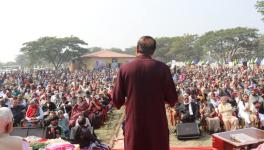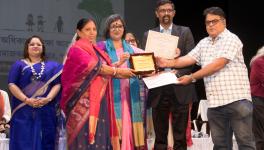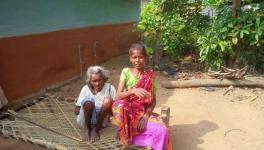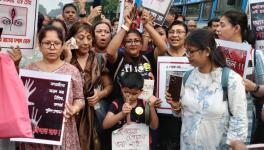Kolkata Junior Doctors Live A Nightmare
Inside premises of Calcutta Medical College (CMC) Hospital at Chitranjan Avenue
Kolkata: A gigantic gate in blue and white, laced with colours of poriborton in Bengal, welcomes you at the entrance of Calcutta Medical College (CMC) at Chittaranjan Avenue. This may seem welcoming, at least to someone who does not frequent government hospitals. But on entering the premises of the heritage institute one can easily smell the rot that the government has tried to shove under the carpet, albeit unsuccessfully.
Even if an individual manages to ignore the heaps of garbage overflowing vats lying unattended on the premises, the unhygienic condition, obnoxious stench and unhealthy air inside the building housing the emergency ward of the hospital cannot be overlooked. And yet hundreds of patients, numerous junior doctors and paramedics ignore the viciousness and unwillingly become part of a decaying system that has become immune to antidotes over decades.
CMC is a microcosm of the rotten public healthcare system in the state where the government has been boasting of improving hospitals since the change of power in 2011.
It has been a few weeks that healthcare is smarting from the body blow dealt by the junior doctors’strike in Kolkata that had rippling effects in other parts of the state as well as the country. The strike followed a mob attack on junior doctors at Nil Ratan Sarkar Medical College and Hospital that left a postgraduate trainee critically injured. Trainees as well as senior doctors across the country joined hands to demand for security at government hospitals.
But the root of the problem runs deep and the discontent and frustration of trainee doctors are only growing. A PGT, or a post-graduate trainee, at Calcutta National Medical College (CNMC) and Hospital said though junior doctors run the show at government hospitals but facilities for them are almost zero.
“It is particularly difficult for women doctors as the toilets are in terrible condition. There is no hygiene and sanitation,” said the doctor, who didn’t wish to be named.
.She pointed out that despite the long hours of duty; no proper restroom is available for doctors. Even the water filter is dirty. “I just close my eyes while filling my bottle. Even after complaining nothing has changed,” she added.
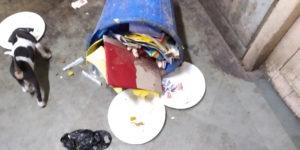
An inside photograph of CMC Hospital
A peek at the doctors’ restroom at CMC revealed the same. The small room despite being air-conditioned, cleanliness seemed alien to it. A lady doctor was curling up at the edge of a bed which was being used to dump bags. Outside the room a litter of puppies were nibbling on the waste spilling from a dustbin. Apart from doctors and patients, canines and felines are aplenty inside the hospital, including the acute medical unit.
This correspondent spoke to several junior doctors and students from CNMC, CMC and SSKM and almost everyone had the same story. But none wanted to reveal their identity fearing repercussions.
Two junior doctors at CNMC were highly critical of the present condition of the hospital in particular and healthcare in the state in general. One of them, who can be referred to as Doctor A, said though the government hospital is getting a facelift outwardly, there remain several lacunae inside.
Doctor A pointed out that the hospital is grossly under-staffed. “Manpower crisis is a major problem. Everyday around 400-500 patients come to the outdoor patient department and there are only five to seven doctors to attend them. Senior or junior doctors not enough. There is a shortage of non-medical staff, so patient parties have to take the stretchers. Junior doctors, besides their usual work, have to do works like drawing blood, taking reports to respective departments, helping patients’ relatives find the right ward,” said Doctor A.
He said while MCI guideline specifies ‘not more than 24-hour duty’, every junior doctor has to spend more time. “Once I had to work for 54 hours at a stretch. After that, can someone expect us to remain in the right state of mind?”
A junior doctor (Doctor B) at CMC echoed the same, “Lack of staff is a perennial problem and we are forced to do clerical work,” she said.
The number of nurses at CNMC and other hospitals is appalling. “There is an immediate need to recruit more nurses as the existing ones are under tremendous pressure”, said Doctor C, adding that interns everywhere have to spend more time on non-medical chores.
However, Dr Raghunath Misra, medical superintendent cum vice principal at SSKM Hospital, downplayed the problem saying interns are there to learn and “we had also done the same”.
“Long working hours is common for doctors. When it comes to overwork then one should understand that those in their internship period are in the learning process. Drawing blood, preparing reports etc are part of their job,” he said.
A group of students at CMC said in most cases senior doctors do not come as the salary is too low. “If you compare the pay scales then you will see that the salary at the central hospitals is almost double of what is given to doctors in state-run hospitals. Why would someone work so hard for a paltry sum,” they explained.
Lack of washrooms is a major problem, especially for nurses and women doctors, and this was pointed out by all the doctors. On lack of basic facilities for junior doctors, Misra said SSKM is trying to improve infrastructure but reluctantly admitted that problems do exist.
Cleanliness at SSKM Hospital is better than any government hospital as the responsibility has been outsourced, informed a junior doctor here who has been working at SSKM for the last three years.
Medicines at government hospitals are supposed to be free but most of the time there is a shortage of supply. “How can there be a shortage when it is written on the board outside that medicines are free? When we tell patients that they have to buy medicines from outside they get agitated,” said Doctor A.
Doctor B pointed out that scarcity of beds not only creates problem for patients but also for doctors. “And yet we take in patients because they need help,” she added.
The condition at RG Kar Medical College and Hospital is equally pathetic. Lack of hygiene, staff crunch, work pressure haunt doctors and patients alike; add to that lack of security, which led to the doctors’ strike. But it’s only the tip of the iceberg. There are numerous problems plaguing government hospitals in the city and it would not be difficult to imagine the condition of healthcare service in rural Bengal.
Dr Sayan Roy, a house staff at CNMC, agreed to the existence of the problems mentioned by the junior doctors, but maintained that changes are being made to improve things. According g to him, there were only four to six neonatal care units in the entire state till 2011 but the number rose to 72 in the last 10 years.
“Also medical college campuses have been extended and new buildings are coming up. Bed numbers have been increased. AC layout room has been introduced. So development is happening,” he added.
While Dr Santanu Sen, secretary of the Indian Medical Association, when contacted did not speak and asked the correspondent to call after 10 minutes. But calls made after that went unanswered. Even a message sent to him asking whether he is willing to speak remained unanswered till the filing of the report. Many IMA members refused to speak saying they were not the right persons to comment.
Get the latest reports & analysis with people's perspective on Protests, movements & deep analytical videos, discussions of the current affairs in your Telegram app. Subscribe to NewsClick's Telegram channel & get Real-Time updates on stories, as they get published on our website.









